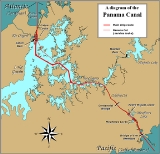
1880 Ferdinand de Lesseps begins French construction of the Panama Canal.
1900 The United States and the United Kingdom sign a treaty for the Panama Canal
1902 The U.S. Congress passes the Spooner Act, authorizing President Theodore Roosevelt to acquire rights from Colombia for the Panama Canal.
1902 The United States buys the rights to the Panama Canal from France.
1903 The Hay-Herran Treaty, granting the United States the right to build the Panama Canal, is ratified by the United States Senate. The Colombian Senate would later reject the treaty.
1904 Construction begins by the United States on the Panama Canal.
1906 Theodore Roosevelt is the first sitting President of the United States to make an official trip outside the country. He did so to inspect progress on the Panama Canal.
1909 Workers start pouring concrete for the Panama Canal.
1913 President Woodrow Wilson triggers the explosion of the Gamboa Dike thus ending construction on the Panama Canal.
1914 The Panama Canal opens to traffic with the transit of the cargo ship Ancon.
1977 The Torrijos-Carter Treaties between Panama and the United States on the status of the Panama Canal are signed. The United States agrees to transfer control of the canal to Panama at the end of the 20th century.
1979 The United States returns sovereignty of the Panama canal to Panama.
1999 The United States Government hands control of the Panama Canal (as well all the adjacent land to the canal known as the Panama Canal Zone) to Panama. This act complied with the signing of the 1977 Torrijos-Carter Treaties.

